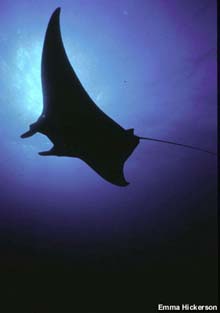
Manta rays, (Manta birostris), may be encountered at the Flower Gardens throughout the year. At least 35 individuals have been identified by Texas A&M University marine ecologist, Jeff Childs. They have identifying markings on their undersides. (Courtesy of Emma Hickerson) Click image for larger view.
Flower Garden Banks National Marine Sanctuary Profile
Underwater Gardens
A pair of underwater gardens emerge from the depths of the Gulf of Mexico, like oases in the desert, 100 mi off the coasts of Texas and Louisiana. Named for the beautifully colored fish and coral rocks that fishermen found there in the early 1900s, the Flower Garden Banks are surface expressions of salt domes beneath the sea floor. This premiere diving destination harbors the northernmost coral reefs in the United States, and serves as a regional reservoir of shallow-water Caribbean reef fish and invertebrates.
Research and Education Objectives
In 2001, the Islands in the Stream Expedition will focus on the characterization of deep- water habitats, with particular emphasis on commercially exploited groupers and snappers that reside along fault scarps and in drowned reefs. The mission will also explore a 60 m-wide brine seep (pool) and an overflow canyon 70 to 100 m deep, and will measure current flows in order to investigate the system’s long-term stability. During an open house scheduled for Galveston, Texas, the public will be invited to tour the ship and see the submersibles and other equipment used in the expedition.
Key Features of the Banks
The Flower Garden Banks comprise 56 sq mi that include two coral-reef-capped banks and one sandstone bank with fire coral and sponge-covered pinnacles and flats. The feature was designated as a national marine sanctuary in 1992, and amended in 1996 to include the Stetson Bank. A digital map of the area identifies these protected areas.
The key habitats to be explored include sand flats, soft sediments, bank reefs, drowned reefs, pinnacles, hard substrate (also called hard bottom), algal sponge communities, brine seeps/flows, fault scarps, and artificial reefs.
Key species include star coral, brain coral, manta rays, hammerhead sharks, and endangered loggerhead sea turtles.
Interesting Facts about the Banks
- Every winter, hundreds of hammerhead sharks and spotted eagle rays school at the Flower Garden Banks for reasons still not understood.
- The East Flower Garden Brine Seep, a 60 m-wide pool of anoxic brine that is seven times saltier than the surrounding water, supports sulfide-oxidizing bacteria that provide a food source for deep-water fish and invertebrates on the bank.
- Every year, seven to ten evenings after the August full moon, corals and invertebrates spawn en masse, filling the crystal clear water over the banks with egg and sperm packets the size of BBs and creating what looks like an underwater snowstorm.
- Corals at the Flower Garden Banks can equal the size of small houses, but certain species don’t exist at all on the reef cap, including all the shallow-water soft corals found elsewhere in the western Atlantic.
- Coral cover, which is an exceptional 50%, and other measures of environmental quality suggest that the Flower Garden Banks have remained healthy since observations of the reefs began in the 1960s.
- Whale sharks the size of buses regularly visit the Flower Garden Banks, but little is known about how they use the resources there (or anywhere else).
- The Flower Garden Banks are the northernmost coral reefs on the North American continental shelf; the only Atlantic reefs found further north are in Bermuda.
- There is some concern that species not normally found at the Flower Garden Banks may be able to invade the site by “island hopping” among the hundreds of oil and gas platforms located on the outer continental shelf in the northwestern Gulf of Mexico.
- The International Maritime Organization recently designated the Flower Garden Banks as the world’s first international no-anchoring zone, opening the way for similar protection of coral reefs throughout the world.
- As far as anyone knows, there are no species unique to the Flower Garden Banks (except perhaps some species associated with the brine seep). Recent studies have shown that the Yucatan Peninsula and reefs in the southwestern Gulf of Mexico supply at least some larvae to the banks, adding to the gene pools generated from the populations already in existence there.
Sign up for the Ocean Explorer E-mail Update List.











































